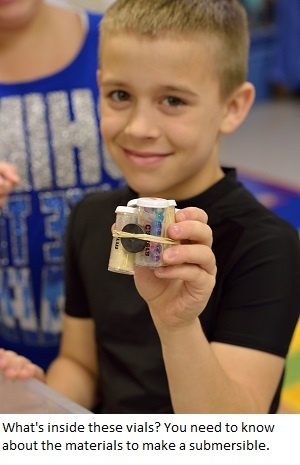Every Engineering is Elementary unit includes four lessons. Lesson #4 is a hands-on design challenge that engages students in designing and building a technology: a windmill, alarm circuit, knee brace, and so on. When I faciliate EiE professional development workshops, participants often ask me: “Do I HAVE to teach all four lessons? Can't I just skip to Lesson 4?"
We know that as an elementary teacher you’re under tremendous time pressure, especially with the current emphasis on preparing for standardized tests. Still, we strongly recommend that you teach all four lessons. This story, from one of our Teacher Educator Institutes, will show you why.
Building Learning, Step by Step
 At our TEIs we ask participants to skip to Lesson 4 on purpose, as a learning experience! I recall one workshop where we started with Lesson 4 from the “Designing Submersibles” unit, where the challenge is to make a model submersible from small plastic vials that contain sand, beads, or marbles.
At our TEIs we ask participants to skip to Lesson 4 on purpose, as a learning experience! I recall one workshop where we started with Lesson 4 from the “Designing Submersibles” unit, where the challenge is to make a model submersible from small plastic vials that contain sand, beads, or marbles.
On this particular day, the participants were deeply frustrated. The design challenge seemed abstract; people wanted to know, "What’s a submersible?" "Why would you need one?" "What’s up with these little vials we’re using to make our model submersibles?" "How do we know which vials will float and which will sink?"
One participant was so upset, she was ready to walk out. That’s when we reminded her this was an exercise in understanding how your students will experience this challenge IF you don’t build the proper background.
We asked, “What do you wish you’d known BEFORE you started the challenge?” The teachers generated a big list of questions—all of which would have been answered if we had worked through Lessons 1, 2, and 3 of the submersibles unit:
- In Lesson 1, they would have read a storybook about a girl who goes snorkeling with a friend; when the friend loses her diving goggles, the girl designs a submersible to retrieve them.
- In Lesson 2, they would have learned about the field of ocean engineering, and the kinds of technologies used for ocean exploration.
- In Lesson 3, they would have systematically tested the different materials for making a model submersible. That would have helped them make connections to their pre-existing science knowledge about how mass and volume influence floating and sinking.
We can’t insist you teach all four lessons, but we strongly recommend it. Think about it this way: you’re not taking time away from math and literacy; you’re creating valuable opportunities to apply and consolidate skills in these subject areas.
Also, learning with EiE builds 21st century skills that standardized tests DON’T measure, like critical thinking, problem solving, creativity, communication, and collaboration.
Don't Skip, But Try These Tips
We do have a few time-saving suggestions:
- Read the Lesson 1 storybook during your ELA period. (To help you integrate EiE with ELA instruction, our Teacher Guide has a vocabulary list and three question sets—pre-reading, during reading, and reflection.)
- For younger students, summarize the storybook instead of reading every page. (Do be sure to include the vocabulary words, the engineering background info, and the context for the challenge.)

- During Lesson 3, assign different groups to test different materials instead of each group testing all the materials. Groups can report back to the class. (Students should still get the chance to at least handle all the materials.)
- In Lesson 4, students work through EiE’s five-step engineering design process (shown at right). The “IMAGINE” step involves an individual assignment, not a group activity. Assign the "Imagine" step as homework rather than in class.
Do you have a classroom tip to share with other EiE teachers? Let us know!
Engineering is Elementary is a project of the National Center for Technological Literacy® at the Museum of Science, Boston.









